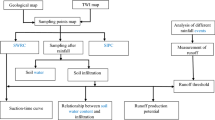Abstract
The infiltration process is a critical link between surface water and groundwater. In this research, a specific device to observe infiltration processes in homogeneous and heterogeneous soils with triangular and inverted triangular profiles was designed, and the Green-Ampt model was employed for the process simulation. The results indicate that (1) the wetting front in coarse texture soils transports faster than in fine texture soils; (2) for the homogeneous case, the wetting front in triangularshaped soils transports faster than the inverted triangular type, but the triangular-shaped soils show a lower infiltration rate; (3) in the initial step, the wetting front in triangular-shaped soils shows higher transport speed, but depicts lower speed with increase in the time; (4) both the wetting front and infiltration rate show a significant exponential relation with the time. From these findings, an empirical model was developed which agrees well with the observed data and provides a useful method for this field of soil research.
Similar content being viewed by others
References
Baker RS, Hillel D (1990) Laboratory tests of theory of fingering during infiltration into layered soils. Soil Science Society of America Journal 54(1): 20–30. DOI: 10.2136/sssaj1990.036 15995005400010004x
Colman EA, Bodman GB (1945) Moisture and energy conditions during downward entry of water into moist and layered soils. Soil Science Society America Proceedings 9(C): 3–11.
Fan Y, Zhao W, Ji H (2012) Numerical simulation of soil moisture distribution and infiltration characteristics of onedimensional vertical infiltration. Journal of Lanzhou University of Technology 9(1): 19–23.
Fan Y, Zhao W, Ji H (2015) Numerical Simulation and Verification of Layered Soil Water Movement in Vertical Onedimensional Infiltration. Bulletin of Soil and Water Conservation 35(1): 215–219.(In Chinese)
Fox YS (1970) One-dimensional infiltration into layered soils. Journal of Irrigation and Drainage Engineering 96: 121–129.
Green WH, Ampt GA (1911) Studies on soil physics, flow of air and water through soils. Journal of Agricultural Science 4(1): 1–24.
Hill DE, Parlange JY (1972) Wetting front instability in layered soils. Soil Science Society America Proceedings 36(5):697–702. DOI:10.2136/sssaj1972.03615995003600050010x
Hillel D, Baker RS (1988) A descriptive theory of fingering during infiltration into layered soils. Soil Science 146(1): 207–217.
Horton RE (1940) An approach toward a physical interpretation of infiltration capacity. Soil Science Society of America Proceedings 5(C): 399–417.
Kostiakov AN (1932) On the dynamics of the coefficient of water percolation in soils and on the necessity of studying it from dynamic point of view for purposes of amelioration. Soil Science 97(1): 17–21.
Li Y, Ren X, Horton R (2012) Influence of various soil textures and layer positions on infiltration characteristics of layered soils. Journal of Drainage and Irrigation Machinery Engineering 30(4): 485–490.
Mein RG (1971) Modeling infiltration component of the rainfall runoff process. PhD thesis, University of Minnesota, Winona, Minnesota. p21.
Miller DE, Carder WH (1962) Water infiltration into stratified soil. Soil Science Society of America Proceedings 26(2): 115–119. DOI: 10.2136/sssaj1962.03615995002600020007x
Philip JR (1957) The theory of infiltration: 4. Sorptivity and algebraic infiltration equations. Soil Science 84(3): 257–264. DOI: 10.1097/00010694-195709000-00010
Richards LA (1931) Capillary conduction through porous mediums. Journal of Applied Physics 1(5): 318–333.
Romano N, Brunone B, Santini A (1998) Numerical analysis of one-dimensional unsaturated flow in layered soils. Advances in Water Resources 21(4): 315–324.
Smith RE, Parlange JY (1978) A parameter-efficient hydrologic infiltration model. Water Resource Research 14(3): 533–538. DOI: 10.1029/WR014i003p00533
Smith RE (1972) The infiltration envelope: Results from a theoretical infiltrometer. Journal of Hydrology 17(1): 1–22. DOI: 10.1016/0022-1694(72)90063-7
Wang H, Huang M, Dong C (2004) Validity of average potential suction Sf of wetting front calculated by parameters in Philip infiltration equation. Bulletin of Soil and Water Conservation 24(2): 41–45.
Wang Q, Shao M, Horton R (1999) Modified Green and AMPT models for layered soil and muddy water infiltration. Soil Science 164(7): 445–453. DOI:10.1097/00010694-199907000 -00001
Wang Q, Shao M, Wang Z, et al. (1999) Application of Green-Ampt equation during infiltration in layered soil. Journal of Soil Water Conservation 5(4): 66–70.
Yang H, Rahardjo H, Leong EC, et al. (2004) A study of infiltration on three sand capillary Barriers. Canadian Geotechnical Journal 41(4): 629–643.
Zhang G, Shao M (2000) Using soil physical properties to determine the absorptive parameter Sf in Green-Ampt infiltration model. Acta Pedologica Sinica 37(4): 553–557. DOI: 10.11766/trxb199905120417
Zhao X, Wu Q (2004) Developments and Reviews of soil infiltration research. Journal of Northwest Forestry University 19(1): 42–45.
Acknowledgments
The study was supported by the National Natural Science Foundation of China (Grant No. 41201268).
Author information
Authors and Affiliations
Corresponding author
Additional information
http://orcid.org/0000-0001-7720-6224
http://orcid.org/0000-0003-3094-4689
http://orcid.org/0000-0003-3859-9613
http://orcid.org/0000-0002-2490-9425
Rights and permissions
About this article
Cite this article
Cheng, Db., Dong, Ly., Qian, F. et al. Observation and modeling on irregular purple soil water infiltration process. J. Mt. Sci. 14, 1076–1085 (2017). https://doi.org/10.1007/s11629-015-3737-x
Received:
Revised:
Accepted:
Published:
Issue Date:
DOI: https://doi.org/10.1007/s11629-015-3737-x




